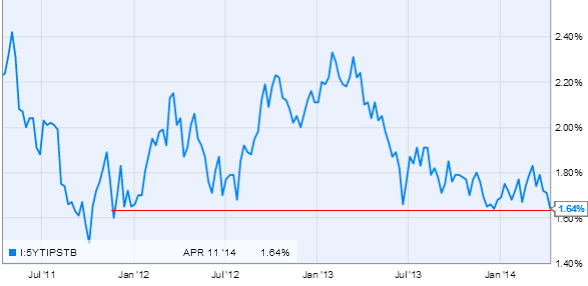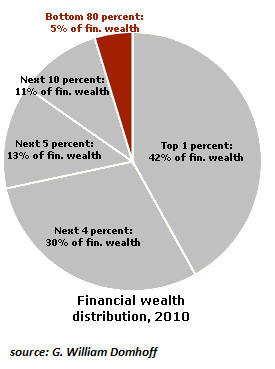| An interesting article this morning via Investment News caught my attention: "After watching the stock market climb from peak to peak last year, investors are finally starting to warm up to equities. More than 85% of investors are feeling optimistic about the investment landscape, and 74% think stocks have the greatest potential of any major asset class, according to a survey of 500 affluent investors released Monday by Legg Mason Global Asset Management. The survey was conducted in December and January. The survey also shows that investors still hold relatively conservative portfolios, but are increasingly willing to increase exposure to international assets." This is not a surprising survey by any measure. In fact, it is typical of what you would expect from a group of individuals whose investment decisions are primarily driven emotional behavior rather than a disciplined investment process. “At the time this survey was conducted, investors had experienced in the U.S. a pretty positive stock market,” said Matthew Schiffman, managing director and head of global marketing at Legg Mason Global Asset Management. “Markets are typically forward looking, while investors are typically backward looking.” Investors are indeed backward looking as shown below. The Investment Company Institute (ICI) began tracking flows into equity funds in 2007 which I have overlaid with the investor psychology cycle. In this manner, you can witness investor behavior in "real time." 
However, the idea that individual investors are still "out of the market" should be taken with a bit of caution. The chart below is data compiled by the American Association of Individual Investors (AAII) which surveys it membership on portfolio allocation. The data is compiled and released monthly. 
With cash hovering at the lowest levels since the "Tech Wreck," and equity exposure at the highest, investors are more than just "warming up" to equities. They are effectively "all in" with respect to the financial markets. An analysis of investor sentiment (both professional and individual) and rising leverage confirm the same. 

What is clear in all of this analysis is that investor behavior tends to be exactly the opposite of what it should be. Of course, this is why over extended periods of time investors tend to vastly underperform their investment goals by: - Chasing last years performance
- Buying high and selling low
- Letting emotions drive investment decisions
- Benchmarking performance
- Not understand the amount of "risk" undertaken
- Focusing on returns rather than preservation of capital
- Failing to understand that Wall Street advice is biased against you.
- Forgetting Warren Buffett's two investment rules "1. Never Lose Principal, and; 2. Refer to Rule #1"
As I have discussed previously, in golf there is a saying that you "drive for show and putt for dough" meaning that it is not necessary to be able to drive a golf ball 300 yards down range, it is the putting that wins the game. In investing it is much the same - being invested in the market is one thing, however, understanding the "short game" of investing is critically important to winning the "long game." The problem, as identified by investor behavior, is that they continually fail to focus on managing the "risk" of the portfolio if favor of chasing "returns." As markets rise success breeds confidence which eventually leads to complacency. The belief that blooms is "this time is different." Somehow, this time economic and investment cycles have been repealed as witnessed by the following statement from the article: “America is already five years out of its recession,” Ms. Tims said. “Europe, meanwhile, has turned the corner more recently. This means that the continent's small and midcap stocks could do very well going forward.” The problem with the statement is that it assumes that the current recovery will last indefinitely, they don't. With both the current economic recovery and "bull market" cycle are already "long in the tooth" by historical standards we are likely closer to the next downturn than not. Investing is not a competition and, as history shows, there are horrid consequences for treating it as such. However, individuals treat it that way by continually clicking a website to see how a particular investment is performing. They are elated when it is rising, but despondent when it falls. It is a "gamblers" addiction to the core. As I discussed recently: Could we have another bullish year in 2014? It is certainly possible as long as the Federal Reserve remains engaged in their ongoing balance sheet expansions. But maybe the ongoing inflation of assets, without the underlying improvement in organic, sustainable, economic growth, will eventually lead to the next market bubble and bust. Of course, for anyone that has paid attention [over the last 13 years], such an outcome would be of little surprise. The important point is that, as an investor, you need to pay attention to the ever decreasing reward/risk ratio of chasing the financial markets. The "low hanging fruit" has long been harvested and the risk currently far outweighs the potential reward of being aggressively invested. I realize that it is not popular, or fun, to rain on the bullish parade. However, while pundits will likely appear to be correct in the short term; the long term outcome will most likely be far less pleasant. All I can do is analyze as many of the facts as possible so that you can make your own financial decisions. However, I can tell you this – Wall Street is a massive organization whose business is to sell you a product. Telling you to get out of the markets is not profitable for them. Therefore, when listening to mainstream analysts and economists make sure and weigh their comments with respect to their financial benefit. One of my favorite quotes is by Howard Marks and is a principle that we live by in our little shop; “Resisting – and thereby achieving success as a contrarian – isn’t easy. Things combine to make it difficult; including natural herd tendencies and the pain imposed by being out of step, since momentum invariably makes pro-cyclical actions look correct for a while. (That’s why it’s essential to remember that “being too far ahead of your time is indistinguishable from being wrong.”) Given the uncertain nature of the future, and thus the difficulty of being confident your position is the right one – especially as price moves against you – it’s challenging to be a lonely contrarian." It may be beneficial to be a little more cautious after such a large rise in the financial markets in 2013. Think about it this way – if you need to grow your assets by 5% per year from now until you reach retirement, then 2013 advanced you 6 years towards your goal. Raising cash and protecting that cushion shouldn’t be a tough decision. However, not doing it should make you question your own discipline. Is “greed” overriding your investment logic? The problem is that when I make such a suggestion, the general comment that is returned is: “But if the market keeps going up – I will miss out.” This is where being a contrarian pays off – as long as you have patience. It is okay to miss out on an opportunity – it is nearly impossible to make up losses. The headlines are rampant at the moment that the "bull market" is set to continue, and maybe it is...for now. The problem, as I quoted in "No One Will Ring A Bell At The Top" " Not surprisingly, lessons learned in 2008 were only learned temporarily. These are the inevitable cycles of greed and fear, of peaks and troughs. Can we say when it will end? No. Can we say that it will end? Yes. And when it ends and the trend reverses, here is what we can say for sure. Few will be ready. Few will be prepared." It is your money after all. If you do not pay attention to it - it is unlikely that anyone else with either. | 






























 Wolf Richter
Wolf Richter









